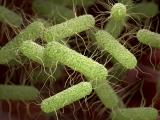Jul 13, 2006 (CIDRAP News) A chemical sanitizer now used in contact lens solutions and toothpaste may help solve the problem of keeping pathogens like Salmonella and Escherichia coli out of edible sprouts, according to a study published in the July issue of the Journal of Food Protection.
When several types of seeds heavily contaminated with Salmonella and E coli O157:H7 were soaked in the sanitizer for several hours, sprouts subsequently produced from them were free of the pathogens, according to the report by a team of Canadian and British scientists. The treatment was not toxic to the seeds.
Outbreaks of Salmonella infection linked with sproutsnormally eaten raware reported periodically. One outbreak in Ontario last year involved 600 people who had eaten mung bean sprouts. The US Food and Drug Administration (FDA) recommends that seeds used for sprouts be soaked in a 2% calcium hypochlorite (bleach) solution, but that measure is not completely effective, according to the Centers for Disease Control and Prevention.
A team led by Keith Warriner, assistant professor of food microbiology at the University of Guelph in Ontario, decided to find out if an existing sanitizer containing chlorite could be used to safely decontaminate seeds used for sprouts. The chemical is a "stabilized oxychloro (SOC)based sanitizer" that is sold commercially as Germin-8-or, according to their report.
"We saw this oxychloro compound that was very detrimental to bacteria and kind to plant cells and our cells," Warriner told CIDRAP News. He said it has been used as a chemotherapy drug as well as in contact lens solutions and toothpastes, "so we knew its properties before we started."
Warriner's group tested the sanitizer on mung bean, alfalfa, and a number of other kinds of seeds, comparing it with the FDA-recommended calcium hypochlorite treatment. Seeds were soaked in a solution containing five different strains of either Salmonella or E coli O157:H7 for 20 minutes and allowed to dry at room temperature.
Batches of contaminated seeds then were soaked for varying intervals in varying concentrations of the sanitizer, and a control batch of mung beans was soaked in the calcium hypochlorite solution for 20 minutes. Afterward the seeds were rinsed with water and allowed to germinate for 4 days. The sprouts then were tested for Salmonella and E coli O157:H7.
The investigators found that a solution of 100 parts per million (ppm) was enough to eliminate E coli from mung bean sprouts, while a 200-ppm solution eliminated Salmonella from the sprouts. In contrast, sprouts from seeds treated with the calcium hypochlorite solution remained heavily contaminated with both pathogens. SOC solutions up to 200 ppm did not significantly reduce seed germination or the yield of sprouts, according to the report.
The experiment also showed that to consistently remove the pathogens, it took between 8 and 19 hours of soaking in the sanitizer and that the minimum ratio of mung beans to sanitizer (weight to volume) was 1:4.
While the treatment eliminated the pathogens, tests showed that treated and untreated batches of seed contained about the same overall levels of bacteria, as indicated by aerobic plate counts. The authors say this suggests that the sanitizer did not affect bacteria naturally associated with the seeds (endogenous microflora).
In trying the treatment on other kinds of seeds, the researchers found that it worked well on alfalfa, soybean, flax, and cress seeds, but results with clover, mustard, and radish seeds were mixed. With several other kinds of seedschick pea, sunflower, buckwheat, sesame, and onionthe treatment failed to prevent contamination.
Why the substance worked on some seeds but not on others is unclear, the report says. But seeds on which the treatment worked germinated faster than the others, suggesting that "protective sites" within the slower-germinating seeds might have protected microbes from the sanitizer, the authors write. They also speculate that natural antimicrobials released by seeds may play a role.
The researchers also tested the sprouts for residual sanitizer and found that none of the samples contained more than 1 ppm, according to the article. Warriner said ingesting significant amounts of the substance would be harmful, but trace amounts are not.
Francis Busta, PhD, director of the National Center for Food Protection and Defense and professor emeritus of food microbiology and emeritus head of the Department of Food Science & Nutrition, University of Minnesota, said the sanitizer looks promising as a treatment at least for some kinds of seeds used for sprouts.
"It appears to be useful within all its limitations," he said. He said the researchers "really loaded up the seeds" with pathogens, making decontamination a tough challenge.
"I think it would have to be individually assessed on the kinds of seeds and sprouts," Busta said. "If I was doing alfalfa sprouts I would strongly consider seeing if I could get this into my protocol. It would also depend on what it costs. A lot of these places [that produce sprouts] are pretty marginal; they don't have a lot of cash flow."
Although SOC is commercially available, it has not been approved for use on seeds in the United States or Canada, according to Warriner.
He said one possible drawback of the sanitizer is that seeds have to be soaked in it longer than what some sprouts producers are used to. "Some people just soak them for 2 or 3 hours. So some people would have to soak the seed a bit longer than they do," he said.
Kumar M, Hora R., Kostrzynska W, et al. Inactivation of Escherichia coli O157:H7 and Salmonella on mung beans, alfalfa, and other seed types destined for sprout production by using an oxychloro-based sanitizer. J Food Protect 2006 Jul; 69(7):1571-78
See also:
Dec 1, 2005, CIDRAP News story about sprouts-linked outbreak in Ontario
http://www.cidrap.umn.edu/cidrap/content/fs/food-disease/news/dec0105salmo.html

















